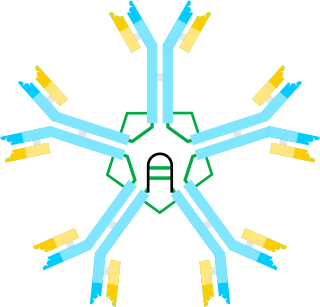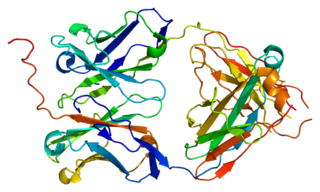Related Research Articles

Immunoglobulin M (IgM) is one of several isotypes of antibody that are produced by vertebrates. IgM is the largest antibody, and it is the first antibody to appear in the response to initial exposure to an antigen. In humans and other mammals that have been studied, plasmablasts residing in the spleen are the main source of specific IgM production.
V(D)J recombination is the mechanism of somatic recombination that occurs only in developing lymphocytes during the early stages of T and B cell maturation. It results in the highly diverse repertoire of antibodies/immunoglobulins and T cell receptors (TCRs) found in B cells and T cells, respectively. The process is a defining feature of the adaptive immune system.

Immunoglobulin class switching, also known as isotype switching, isotypic commutation or class-switch recombination (CSR), is a biological mechanism that changes a B cell's production of immunoglobulin from one type to another, such as from the isotype IgM to the isotype IgG. During this process, the constant-region portion of the antibody heavy chain is changed, but the variable region of the heavy chain stays the same. Since the variable region does not change, class switching does not affect antigen specificity. Instead, the antibody retains affinity for the same antigens, but can interact with different effector molecules.

The immunoglobulin light chain is the small polypeptide subunit of an antibody (immunoglobulin).

The Joining (J) chain is a protein component that links monomers of antibodies IgM and IgA to form polymeric antibodies capable of secretion. The J chain is well conserved in the animal kingdom, but its specific functions are yet to be fully understood. It is a 137 residue polypeptide, encoded by the IGJ gene.

Leukocyte immunoglobulin-like receptor subfamily B member 1 is a protein that in humans is encoded by the LILRB1 gene.

CD83 is a human protein encoded by the CD83 gene.

Lymphotoxin-beta (LT-beta) also known as tumor necrosis factor C (TNF-C) is a protein that in humans is encoded by the LTB gene.

Immunoglobulin lambda-like polypeptide 1 is a protein that in humans is encoded by the IGLL1 gene. IGLL1 has also recently been designated CD179B.

Ig mu chain C region is a protein that in humans is encoded by the IGHM gene.
T cell receptor delta locus, also known as TCRD or TRD@, is a protein that in humans is encoded by the TRD gene. It contributes the delta (δ) chain to the larger TCR protein.

Ig epsilon chain C region is a protein that in humans is encoded by the IGHE gene.

Ig gamma-2 chain C region is a protein that in humans is encoded by the IGHG2 gene.
Immunoglobulin lambda locus, also known as IGL@, is a region on the q arm of human chromosome 22, region 11.22 (22q11.22) that contains genes for the lambda light chains of antibodies.

Immunoglobulin iota chain is a protein that in humans is encoded by the VPREB1 gene. VPREB1 has also recently been designated CD179A.

Leukocyte immunoglobulin-like receptor subfamily A member 3 (LILR-A3) also known as CD85 antigen-like family member E (CD85e), immunoglobulin-like transcript 6 (ILT-6), and leukocyte immunoglobulin-like receptor 4 (LIR-4) is a protein that in humans is encoded by the LILRA3 gene located within the leukocyte receptor complex on chromosome 19q13.4. Unlike many of its family, LILRA3 lacks a transmembrane domain. The function of LILRA3 is currently unknown; however, it is highly homologous to other LILR genes, and can bind human leukocyte antigen (HLA) class I. Therefore, if secreted, the LILRA3 might impair interactions of membrane-bound LILRs with their HLA ligands, thus modulating immune reactions and influencing susceptibility to disease.

Leukocyte immunoglobulin-like receptor subfamily A member 2 is a protein that in humans is encoded by the LILRA2 gene.

Cluster of differentiation CD79A also known as B-cell antigen receptor complex-associated protein alpha chain and MB-1 membrane glycoprotein, is a protein that in humans is encoded by the CD79A gene.

Fc fragment of IgA receptor (FCAR) is a human gene that codes for the transmembrane receptor FcαRI, also known as CD89. FcαRI binds the heavy-chain constant region of Immunoglobulin A (IgA) antibodies. FcαRI is present on the cell surface of myeloid lineage cells, including neutrophils, monocytes, macrophages, and eosinophils, though it is notably absent from intestinal macrophages and does not appear on mast cells. FcαRI plays a role in both pro- and anti-inflammatory responses depending on the state of IgA bound. Inside-out signaling primes FcαRI in order for it to bind its ligand, while outside-in signaling caused by ligand binding depends on FcαRI association with the Fc receptor gamma chain.

CD8a, is a human gene.
References
- ↑ "Human PubMed Reference:". National Center for Biotechnology Information, U.S. National Library of Medicine.
- ↑ "Entrez Gene: Immunoglobulin lambda joining 3".